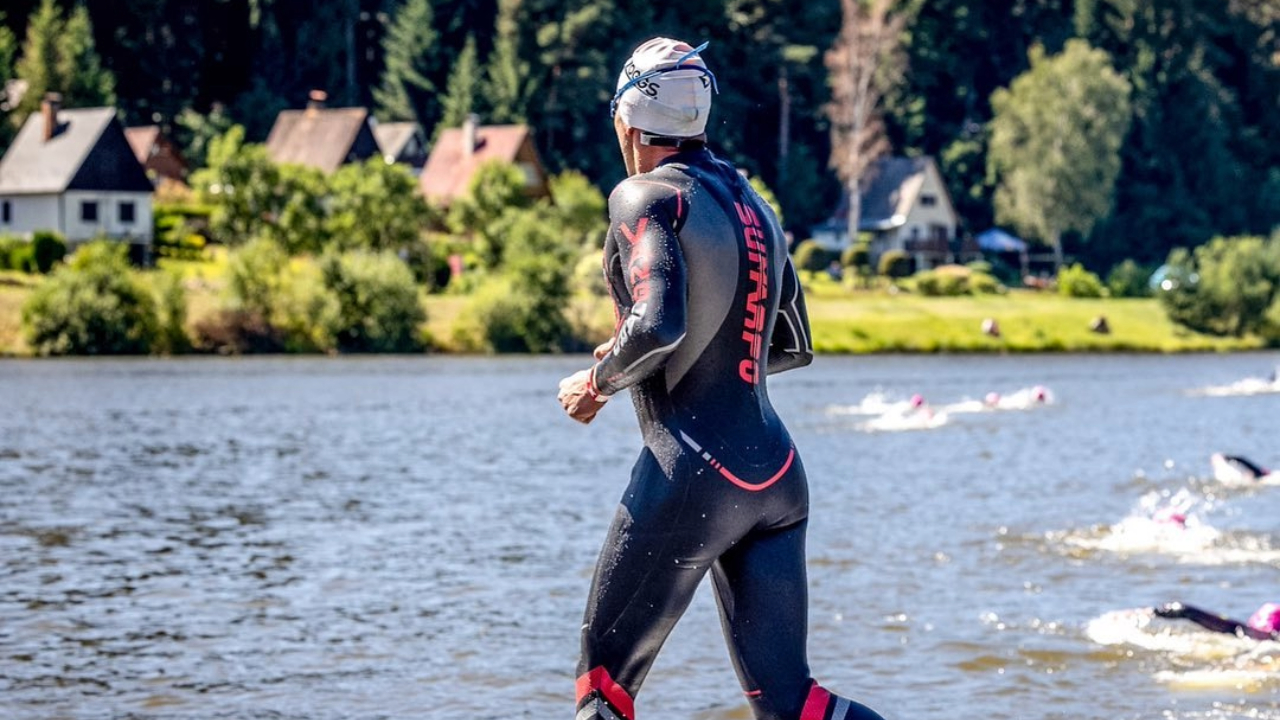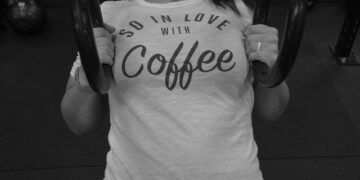Whether you’re looking to get a new PR at your next triathlon, or just want to have a little less ground to make up once you get out on the bike. Getting faster at open water swimming is something plenty of triathletes strive towards. But those swim gains can be hard to come by.
With insights from PRO triathletes and international elite-level coaches, top Masters swimmer Helen Gorman shares training advice to help you improve your swim speed on race day. From the pool training sets to boost your fitness and pace. To the open water skills you need to fine tune to make sure you can put all your hard training into practice once you hit the open water.
Focus on combining endurance with pace
Triathlon and open water swimming races are endurance events. Even a sprint triathlon has a 750m swim, which is going to take most people more than ten minutes to complete. Developing raw swimming power and speed isn’t necessary, but training your energy systems to perform above the level of your current best times will help you to swim faster.
Great Britain coach, Glenn Smith, who was the childhood coach of 2008 Olympic 400m and 800m freestyle champion, Rebecca Adlington says. “We are looking to develop ‘pace’ rather than ‘speed’.” He is keen to point out that you need aerobic fitness to maintain speed and hold a specific pace. “You need to build up the engine in a gradual fashion. Swimming 1500m, 1900m or 3800m requires being aerobically fit, especially if you want to do it at a specific pace.”
 Incorporating efforts at race pace, or just above, to complement your endurance triathlon swim training will help to improve your overall swim speed.
Incorporating efforts at race pace, or just above, to complement your endurance triathlon swim training will help to improve your overall swim speed.
Once that aerobic fitness is in place, to start bumping up your speed you need to introduce pace work into your swimming schedule. Let’s say your goal is to swim 1500m in under 25 minutes. You’ll need to be able to hold a pace of 1 minute 40 seconds per 100m. To train your energy systems to be able to hit that pace and hold it for 1500m, Smith suggests incorporating 50m interval sets into your training at slightly above that pace. In this instance – targeting around 46-47 seconds for 50m (1:14/100m), and taking 10-15 seconds rest between each interval. 10 x 50m is a great pace set to start with.
To adapt the pace set to your own ability, first identify what time you’d like to target for a set distance. Work out what pace you would need to hold per 100m to achieve that time. Then aim to complete 50m repetitions at slightly above that pace.
Maintain good technique
A common mistake we can all make when we try to swim faster is letting our technique break down. This means we become less efficient, expending more energy and losing speed. So when you’re doing speed work, it’s important to focus on maintaining good technique.
info-circle PRO swim set: INDIA LEE’S RACE PACE EFFORTS TRAINING SESSION
PRO triathlete and Miami T100 champion India Lee does a race specific swim set practically every week as part of her training. She says this set “mimics the intense start of a race and then having to settle into race pace intensity.” Check out her set below if you want to have a go at training like a PRO!
4 x 50m max effort with reducing rest: 60, 50, 40, 30 seconds
300m CSS pace (see below for CSS explainer)
200 pull + paddles – upper aerobic effort (zone 3)
Repeat x 4
But without a coach on pool side to keep an eye on your form, what’s an easy way to check in with your technique while you swim? Paul Eaglestone, childhood coach of Olympic hopeful Alex Yee suggests using your stroke count. “It is important to know your stroke count when swimming at pace, so always be aware how many strokes you do for a fast 25m. This can give you a metric to use when doing long or high intensity swims in a pool and give you a good indication of when your technique is breaking down.
“If your stroke count is dramatically higher than normal, I would recommend taking a rest to reset yourself both physically and mentally.” Take plenty of rest between speed repeats and focus on maintaining good technique even as you push the pace.
What is CSS in swimming?
CSS – Critical Swim Speed – is the theoretical fastest pace that a swimmer can maintain continuously without exhaustion. It is your aerobic swimming threshold and can be calculated by swimming a 400m and a 200m time trial and putting your times into an online calculator to work out your 100m pace.
When to do speed work for open water events
Smith maintains that you must first build the engine before adding in threshold and pace sets in the lead up to your main open water swimming event. However, you can incorporate short speed burst and drills into your warmups all year round. Try using fins to feel extra fast and paddles (if your shoulders are ready for them) to do short, power-based sets.
Ideally, your threshold and pace work would start when the racing season starts, and you could complete two-three key sets per week during the competition season.
Six weeks out from your main race, Smith suggests doing 3 x 200m as hard as possible with approx. 3-4 minutes between each one. After that, he recommends reducing the volume of threshold work, but maintaining your overall swimming volume with aerobic work and regular speed work as part of warmups.
Open water skills to help you swim faster
Refining and perfecting your open water racing skills will ensure that you are swimming the shortest possible distance. Swimming off course or going too wide around turn buoys can add up to a lot of extra metres!
Professional triathlete, Jodie Stimpson, has a very simple tip for staying on course: “I breathe more regularly in open water to make sure I’m heading in the right direction.” Each breath will give Jodie an opportunity to ‘sight’ – a quick look forward to make sure you’re swimming towards the correct buoy or landmark.
Ideally, you should practice sighting while swimming in open water. But if you do most of your training in a pool, you can still practice sighting by incorporating a quick look forwards at something at the end of your lane during each breath. This is a good drill set to do as part of your warmup and you can develop a breathing pattern that works for you.
 Sighting is key to staying on course and not losing time, particularly in choppy conditions.
Sighting is key to staying on course and not losing time, particularly in choppy conditions.
Drafting can also make a big difference to your speed in open water. Swimming behind someone and following them can save a significant amount of energy, but you still need to make sure they are following the right lines and not leading you off course! Practice swimming closely behind another swimmer in training, while also sighting every few strokes to make sure you’re still on course.
India Lee said: “Drafting is part of racing, and I’m not afraid to touch the feet in front of me. I don’t mind when someone is swimming on or touching my feet. However, if I want to drop them, I’ll try some swerving or wait until I get to a buoy and put an effort in around it to get some space.”
Swimming gear to optimise your speed
Fitness, strength and skill are a big part of the equation when it comes to improving your pace in open water. But your choice of swimming gear can also have a significant impact! Choosing the best wetsuit for your swim style, or getting a swim skin for non-wetsuit events will help you to swim faster. And making sure your goggles are suitable for open water swimming will make it easier to stay on course and not lose time by accidentally swimming extra distance.
Choose the best wetsuit
Choosing the right wetsuit is key for making the most of your speed out in open water. An ill-fitting wetsuit, or a wetsuit that is too restrictive around the shoulders can create additional drag in the water, limit your range of motion and cause your shoulders to fatigue faster.
Make sure you’re opting for a swimming specific wetsuit, rather than a surfing suit, will be much faster as it will have a smooth coated neoprene surface to reduce friction. A full cut wetsuit is usually the fastest option, too. Neoprene is faster and more buoyant than skin, so the more coverage you have, the faster you will swim.
Premium wetsuits will have thinner neoprene around the shoulders and upper back to aid thoracic mobility, which enables better stretch and reach from each stroke. Regardless of what you spend, a suit needs to fit you properly and you need to spend time putting it on correctly. Most retailers and wetsuit brands are more than happy to discuss sizing with you, and some will even offer a try-before-you-buy option.
Eaglestone recommends training in your suit before your event: “You need to know how swimming in a wetsuit affects your technique; for most people it is always a positive experience because of the added buoyancy. I recommend open water practise in a pool or lido before your first open water experience.”
A swim skin can help to boost your speed in non-wetsuit triathlons
If you are lucky enough to race somewhere warm, wetsuits may not be allowed. Triathletes have the option to wear a swimskin over their tri suit – take a look at race footage from the IRONMAN World Championship in Kona, for example, or the recent Singapore T100 and you’ll notice the PROs wearing a swim skin over their tri suits.
These suits are made with similar hydrophobic fabrics worn by elite pool swimmers. They extend down to the knee and can be sleeveless or have sleeves. While a swim skin won’t offer the additional buoyancy of a wetsuit, the hydrophobic fabric can help you to be more streamlined in the water – and therefore swim faster.
The gains aren’t necessarily huge for your average age-grouper, but if you’re looking to save vital seconds – every little helps. Just don’t forget to remove it after the swim – a mistake Jan Frodeno very nearly made at the PTO US Open in 2023! A swim skin isn’t designed for breathability so you definitely don’t want to keep it on during the bike leg of a triathlon.
Opt for smoked or mirrored open water swimming goggles
While the ultra low profile, small-framed goggles you’ll see pure pool swimmers wearing in races are the fastest for hydrodynamics. In open water, it’s more important that you can see where you’re going so you don’t swim wildly off course.
Look for goggles that offer a good field of vision. And if you’re likely to be swimming in bright conditions choose ‘smoked’ or mirrored goggles that will help to reduce some of the glare from the sun. Most triathlons take place early in the morning when the sun can be low in the sky, making it difficult to see if you’re wearing clear goggles.
Quick-fire recap
How do I get faster at open water swimming?
To improve performances in open water swimming, you need to train consistently, do some race pace interval training in the lead up to your event, ensure that you swim the shortest possible line by looking where you’re going (sighting) regularly and develop a pacing strategy that suits you.
What type of swim sets will help increase speed?
In the lead up to your event, do some short interval repeats at a faster pace than your current best performances. For example, if you swim 1500m in 25 minutes, that’s an average pace of 50 seconds per 50 metres. In training, aim to swim 10 x 50m holding 47 seconds per 50 metres with around 10-15 seconds rest.
Do I need to change my swimming technique from the pool to open water?
Good technique in the pool will translate into good technique in open water. However, you may need to alter your breathing pattern to ensure that you are aware of your surroundings and look where you are going. This is particularly true of choppy conditions where it may be more difficult to see your destination and you need to sight more often.
Is drafting legal in open water swimming?
Drafting is legal and very much part of racing in open water swimming. You can save a lot of energy by swimming directly behind someone, but make sure they are staying on-course and not leading you off in the wrong direction!
Which is the fastest wetsuit?
The fastest suits are open water/triathlon specific with a smooth skin coating. They extend to your ankles and wrists and tend to have thinner materials around the shoulders and thoracic area to aid reach and rotation. Check out our wetsuit buying guide for more help choosing the best wetsuit for your swim style.
>>> Read full article>>>
Copyright for syndicated content belongs to the linked Source : Tri247 – https://www.tri247.com/open-water-swimming/how-to-get-faster-at-open-water-swimming-triathlon-swim-training-tips-advice-gear-wetsuit?utm_source=rss&utm_medium=rss&utm_campaign=how-to-get-faster-at-open-water-swimming-triathlon-swim-training-tips-advice-gear-wetsuit































